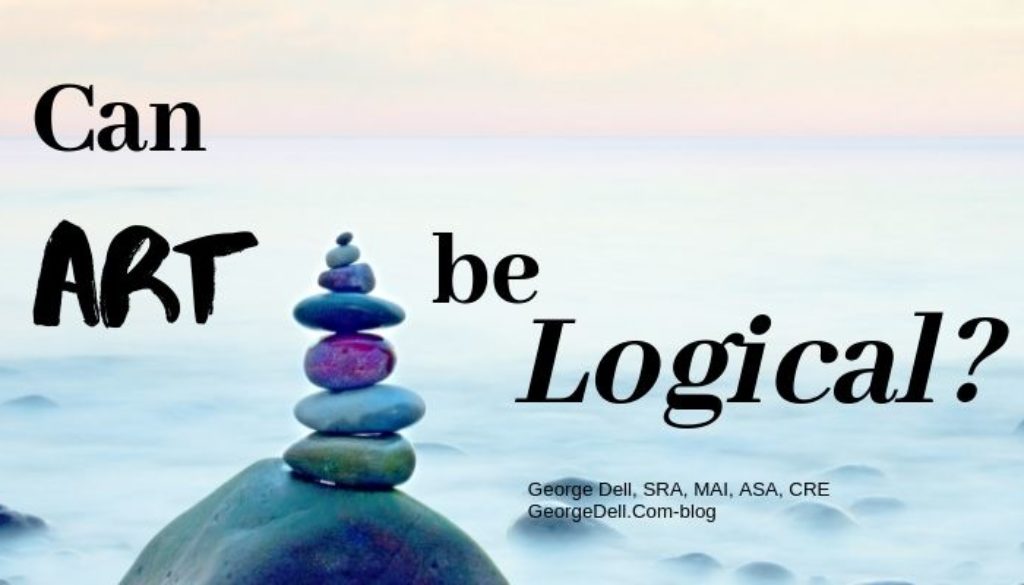Is the science of Logic in art? Is there art in the science of data?
Ask any musician or artist. We have perspective, the golden ratio, octaves, and even measurable human body and brain responses to music, visuals, and other sensual inputs.
I have never read or heard a data scientist say there is no art in the discipline. Most scientists, whether in the ‘hard’ disciplines, or the ‘softer’ social sciences, recognize and even exalt subject-specific knowledge. Chemists know chemistry. Engineers study many specialty fields. Medical researchers often have highly specialized field knowledge in particular diseases, body parts, or even brain neurons.
And there are three critical types of thinking associated with the blend of science and art. First let’s define again what is science: “the systematic study of the structure and behavior of the physical and natural world through observation and experiment. Shortened for appraisers, the science is:
- A Systematic study,
- through observation.
‘Observation’ is emphasized, because appraisers cannot set up experiments. The three types of scientific reasoning include: abductive, inductive, deductive.
Deductive is absolute logic. Inductive recognizes variation. Abductive uses prior knowledge (like appraiser education, experience, and market familiarity.
Deductive reasoning is the most familiar. It is absolute, like math: 2 + 3 is always 5. Generalized in algebra: a + b = c, the result is determined exactly.
Inductive reasoning is probabilistic. Things vary. 2 + 3 + [variation] ≈ 5 [approximately]. Generalized in a + b + Ɛ = c, where the Ɛ (epsilon) is the ‘error’ term. This is interesting, because valuation is all about identifying the right a’s and b’s, recognizing the variation Ɛ, then working to minimize that error, the Ɛ.
Abductive reasoning is an art, which goes from given assumptions and observations to a personal theory which seems to best account for the observation. For appraisers, the assumptions and observations include the client’s needs, definition of value, subject parameters, and relevant data set. The goal is to find the simplest and most likely explanation, incorporating prior experience. Abductive reasoning deals with the setup in the first place. What is the ‘c’ solution needed? What a’s and b’s are required? And what function (the ‘+’, the math, the algorithm, formula, or relationship) is appropriate?
But wait, there’s more!
Look at the last three sentences above. The analyst determines the a, b, and c, the goal to minimize Ɛ, and the algorithm (approach) to apply. Whew! All involving expert judgment.
The a’s and the b’s are your data (comps?). The ‘c’ is the problem to be solved: point value, market price, given date, other assumptions and conditions. Ɛ is to be minimized. This is the point of your predictive analysis.
In an upcoming TAAR (The Asset Analyst Report) and CIAR (Collateral Investor Assay Report), we will more deeply explore this analysis of measuring the variation, in order to minimize it. (You cannot tell how well you are doing, unless you can measure it). In this case, it is the sureness of your Ɛ, the error term. To measure the Ɛ is the objective of the Asset Analyst©.

June 12, 2019 @ 10:10 am
This cuts to the essence and the importance of the “art” portion of our practice. Appraisers are leaders in interpretive science as we seek to bridge the inconsistencies found not only in the data but also the perspectives by which we analyze through the approaches to value. Why do coastal markets continue to rise in value even with the growing threat of sea level rise? What does create value? To me its a wholly human concept that might be better explained by examining art and our response to it. I recommend Ellen Winner’s book “How Art Works, A psychological explanation”. She is a fine scientist with solid research methodology that gives me hope as I parse market conditions, attempt to validate adjustments and lay a sure path in the final reconciliation. Thank you George for challenging us to think.
June 12, 2019 @ 10:16 am
Maybe better stated by Lord Kelvin: “When you can measure what you are speaking about, and express it in numbers, you know something about it, when you cannot express it in numbers, your knowledge is of a meager and unsatisfactory kind; it may be the beginning of knowledge, but you have scarely, in your thoughts advanced to the stage of science.”
August 19, 2021 @ 9:13 am
Thank you for your quote.
How perfect!